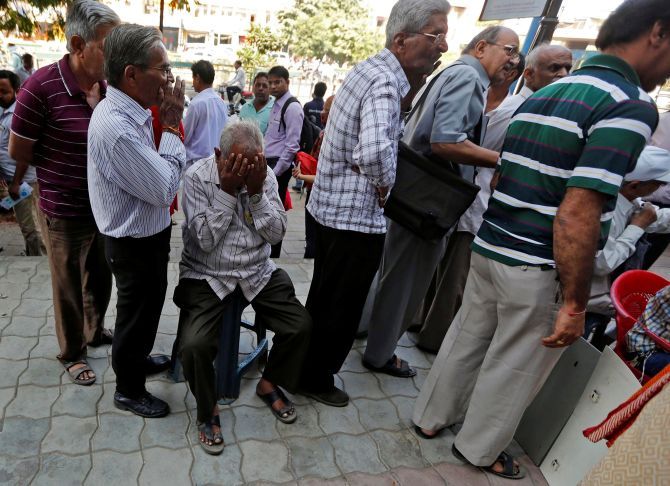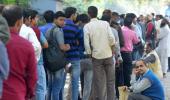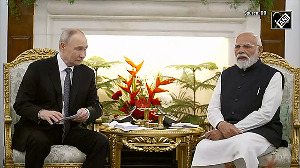With GDP down by 2 per cent, and with 99 per cent of banned notes making their way back into the banking system, whom did demonetisation benefit?
Rediff.com's Utkarsh Mishra explains.

What was the objective of demonetisation, or note ban, whatever you call it? And has it been achieved?
Perhaps the architects of the scheme, if there are any, themselves don't know.
There are many who claim it was a success, and there are others who say it wasn't. And not all of them are economists.
Although economics is one thing and common sense is another, being an economist lends credence to one's observation about demonetisation, presumably.
But was demonetisation really a decision with purely economic aims? Or, as former Reserve Bank of India governor -- and perhaps one of the best our central bank has had -- Y V Reddy wrote, it 'might not have been the result of calculated risk taking, but may have been taken out of inspiration or political instinct’.
And if this was indeed the case, any scrutiny of the exercise along economic parameters is futile.
However, in this case, as is the case often these days, even common sense is happily sacrificed at the altar of political leanings.
And, therefore, Ajay Devgn calling it a masterstroke trends higher than Amartya Sen calling it 'despotic action'.
The defenders of the scheme dismiss the economists trying to make sense of the government's arguments as leftists who criticise everything Prime Minister Narendra Modi does.
But, if the line that 'Modi haters will criticise anything he does' holds, so does the line that people who venerate the PM will defend anything he does, however disruptive or destructive it might be.
And this extinguishes the scope of any argument or discussion. But at the same time, it is important to set the narrative right.
It is time to agree with those who hail #DemonetisationSucess because the objective they had in mind has certainly been served, and served well.
The stated objectives of demonetisation
Let's start with the PM's November 8 speech.
He said, 'Which honest citizen will not be pained by reports of crores worth of currency notes stashed under the beds of government officers? Or by reports of cash found in gunny bags? The magnitude of cash in circulation is directly linked to the level of corruption.'
'High circulation of cash also strengthens the hawala trade which is directly connected to black money and illegal trade in weapons,’ he added.
He continued: ‘To break the grip of corruption and black money, we have decided that the Rs 500 and Rs 1,000 currency notes presently in use will no longer be legal tender… The 500 and 1,000 rupee notes hoarded by anti-national and anti-social elements will become just worthless pieces of paper.’
Two things stand out in these remarks.
First, the PM thought that most of the black money was kept in wads of cash and the ‘anti-national and anti-social’ elements have more of the currency notes than the 'honest, hard-working' citizens.
Second, he made it very clear that cash was the problem. So the subsequent narrative of the note ban being an attempt to create a 'cash-less' or 'less-cash' economy was not completely missing from his speech, as some would argue.
What common sense fails to understand is that in the same speech, the PM said, '... as part of this exercise, RBI's recommendation to issue 2,000 rupee notes has been accepted.'
But if high denomination notes were the problem and large cash transactions was being eased out, what was the rationale in issuing an even higher denomination note after banning the lower ones?
Moreover, the PM also said that new Rs 500 notes will be issued. So, in that sense, it was merely a currency exchange, and not exactly demonetisation.
By issuing new Rs 500 and Rs 2,000 notes in place of old Rs 500 and Rs 1000 notes, the PM did not put an end to large cash transactions, but merely rendered those pieces of Rs 500 and Rs 1,000 notes that were in circulation at that time, useless.
Much of the purpose of the exercise was thus defeated then and there.
And it also defeats the argument listing out precedents of demonetisation -- be it the Morarji Desai government banning Rs 1,000, Rs 5,000 and Rs 10,000 notes or United States Fed discontinuing bills higher than $100. In none of those instances new notes of similar, or higher, denomination were issued.
It would still have been worth something if the 'anti-national and anti-social elements' had more of Rs 500 and Rs 1,000 notes in their possession than the common public.
So the success of the exercise did depend on how much money comes back into the system, contrary to what the Union finance minister is suggesting now.
It was said at that time that whatever amount of money doesn't come back, RBI's liability would be shed to that extent and transferred as profit to the government.
However, on one hand, 99 per cent of banned currency is back in the system, and on the other, RBI's dividend to the government fell almost by half this year. This includes the losses incurred in printing large amounts of new currency in such a short time.
On the face of it, it also indicates that 99 per cent of banned notes were held by those who could reach banks and deposit their money. And not by those, as the PM suggested in subsequent speeches, who were throwing their notes into the river in frustration.
Expansion of tax base and trail of undisclosed income
FM Arun Jaitley now says the objective was not the seizure of cash but formalisation of a hitherto informal economy. He says people were forced to deposit their undisclosed incomes in banks and now we can trace the depositors.
There's a minor problem with this argument.
The structure of note ban was not such as to stop the generation of black income. It merely rendered unreported income held in old Rs 500, Rs 1,000 notes useless.
Why would someone smart enough to fudge the books to evade tax, risk disclosing unreported income, if the loss otherwise is just a portion of it held in cash getting wasted?
Moreover, the income-tax department can only say that these many people are under the scanner for high cash deposits during the note ban. They can’t say -- and haven’t said -- how much of it is unreported income until the completion of their investigations.
What if most of the depositors succeed in explaining their deposits? Will the exercise then be considered successful?
Because 99 per cent of the cash coming back into the system points to only two possibilities: Either the corrupt have become audacious enough to deposit large amounts of unreported income despite warnings of the I-T department, or they have kept their explanations ready.
As far as the expansion of tax base goes, the income declaration scheme and the goods and services tax regime have done a better job than demonetisation.
If one really wants to disclose one's black income, one would certainly go for a scheme which entails less tax and not for one which involves a 75 per cent tax.
And if they're to be compelled to declare their black income, something like GST would any day do a better job than note ban because the loss to the corrupt in the case of the former is permanent while in the case of the latter it is temporary.
Whatever the increase in the number of taxpayers -- because the PM, the FM and the chief economic adviser don't seem to agree on a figure -- a report in Indian Express said that most of it are small taxpayers in the income group of Rs 5 lakh and below.
Even if only the note ban is credited with bringing in these new taxpayers, it was not worth the pain and suffering endured by countless common people.
The hiccups are temporary, really?
Do we remember the forex crisis created by the Rajiv Gandhi government and how India grappled with it from the late 1980s to early 1990s? Do we feel its ramifications now?
Speaking in Parliament on the note ban, Dr Manmohan Singh aptly quoted economist John M Keynes: 'In the long run, we're all dead.'
From any crisis, we recover someday. That doesn't mean we dismiss the immediate disruption -- in the case of the note ban it was destruction -- a policy causes.
The Economic Survey agreed that the note ban slowed growth and the manufacturing sector.
Thousands of people lost their jobs and means of livelihood. They won't agree that it was only temporary.
Meanwhile, the temporary slowdown has now extended to two quarters, wiping out lakhs of crores from India's gross domestic product. The predictions of higher growth in the next quarter are as good as they were for the last quarter.
It would be proper if the disruption caused by GST is termed as temporary. But the effect of note ban on the lives of millions of people can't be dismissed as temporary.
Promoting digital transactions
Do you really need demonetisation to do that?
And besides, an NDTV report quoted RBI's data on digital transactions showing 'they have dropped to pre-demonetisation levels, both in terms of the number of transactions, and its value'.
True, there was a spike in digital transactions during the note ban because, obviously, there was no cash.
The RBI had also said recently that 'remonetisation' was 'more or less complete'.
So what happened to the cashless economy?
What did note ban achieve?
People of India were fed up with a new scam being unearthed every day during the last years of the United Progressive Alliance II.
The agitation led by ‘India Against Corruption’ made people less patient and resilient.
It did put off a few later when Arvind Kejriwal formed a political party, fought elections, allied with the same Congress that people voted out, then resigned after 49 days and, in the meanwhile and thereafter, indulged in a lot of theatrics.
At the Centre Narendra Modi filled the gap the IAC fallout had created.
He promised people a corruption-free society and freedom from dynastic rule. His entire campaign was based on overhauling the corruption-infested system.
His overwhelming victory obliged him to deliver on his promises. He took a few good steps to curb corruption, like bringing in legislation against benami property and black money and restricting large cash transactions.
But a move was needed that affects the common people directly, to convince them that radical reforms are underway and that Modi will take India to greater heights.
So Dr Y V Reddy was right in pointing out that ‘political instinct’ overpowered the economic one while the note ban decision was taken.
Unusually, time and again the PM indulged in a war of words, countering arguments against the scheme.
He successfully termed all those arguing against the scheme as being against the 'war on black money and corruption', something the people of India wanted for long.
Not just that, the move, coupled with a reduction in the limit in individual donations to political parties from unknown sources, hit other parties much harder than the Bharatiya Janata Party.
A recently released Association for Democratic Reforms report suggested that out of over Rs 956 crores donated by corporate houses to various political parties, more than Rs 705 crore went to the BJP.
The Congress came a distant second with Rs 198 crores.
Although I-T returns of the parties assessed by ADR show that the BJP also tops the list in case of donations by 'unknown sources', there are parties like the Bahujan Samaj Party which rely -- according to themselves -- more or less completely on such donations.
The BSP declared that it 'did not receive any donations above Rs 20,000 in the past 11 financial years'.
Provisions of the I-T Act required payments exceeding Rs 20,000 to be made through banking channels. This limit has now been brought down to Rs 2,000.
On the other hand, the cap on corporate donations has been removed by the FM with the introduction of electoral bonds. It also facilitates anonymous corporate funding to parties.
The ADR numbers clearly suggest who would be the biggest beneficiary of the scheme.
And we saw during Uttar Pradesh elections how Mayawati could barely campaign.
The note ban decision hit the booth-level organisation of regional parties.
If the note ban was aimed at ensuring bigger electoral successes for the BJP, it achieved its purpose.
And those who want to see the party attain greater political heights will always consider note ban a success.
Arguing in economic terms with them is a waste of time.










